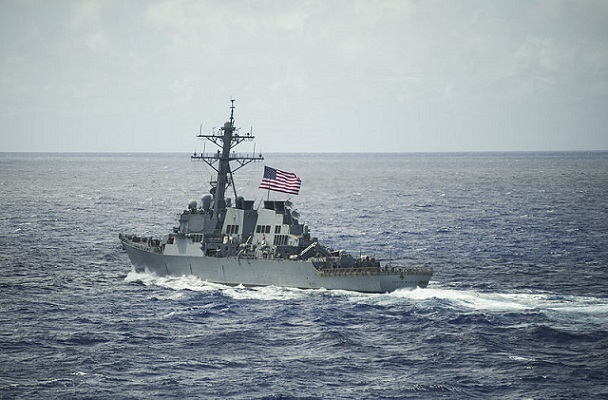
By CHARMAINE DEOGRACIAS, VERA Files
In a departure from the previous administration’s support of the United States freedom- of-navigation activities in the South China Sea, Defense Secretary Delfin Lorenzana said Thursday. the Philippines for will not allow the use of former American military bases – Clark and Subic -for FON patrols of the United States Armed Forces.
Lorenzana said President Duterte is not in favor of U.S. vessels venturing into disputed waters in the South China in the name of freedom of navigation.
“As he said we will avoid any provocative actions to de-escalate tension in the South China Sea. So I think it is unlikely (that Philippines will support US FON operations),” Lorenzana said in doorstop interview at the Pilipinas Conference held at the Peninsula Hotel.
Asked further to explain the Philippines’ turn-around, Lorenzana said, “We are just trying to avoid tensions because one of the things that we see there is, to the Chinese, we allow our land as base for the American’s incursion towards their area, so we will avoid that.”
The US has vowed to continue their freedom of navigation operations in the South China Sea where where some $5.3 trillion worth of trade pass yearly. Pentagon confirmed to have conducted routine patrols last month near Chinese holdings in Triton and Woody island in the Paracels in the South China Sea off the coast of Vietnam. US warship USS Decatur’s (DDG-73) routine patrol there was the latest freedom of navigation operations since USS William Lawrence (DDG-110) conducted the same near the Chinese installation on Fiery Cross Reef in the Spratly Island chain. In January, they conducted the same near Subi Reef close to the Philippine-held Pag-asa island.
The Philippines defense chief said the arrangement with US now is for them to launch their freedom of navigation operations from elsewhere, but not from the Philippines.
“Anyway it is still possible for the US to fly over there coming from their other bases like Guam, Okinawa or from their aircraft carriers. So that’s the arrangement for now not to use Clark or Subic,” Lorenzana said.
Subic Bay, a former US naval base remains to accommodate visiting and transiting US military ships. The US continues to use Clark airbase for joint training with the Philippine military. US operated Both Subic and Clark from 1903 until 1991 when the Philippine Senate rejected the bases treaty allowing American forces to operate in the country.

Under the governments of Pres. Benigno Aquino III and U.S. President Barack Obama, the U.S.and the Philippines signed an Enhanced Defense Cooperation Agreement (EDCA) that will allow US to preposition troops and equipment in mutually agreed locations in the country for rapid response in crisis and emergency situation.
Both Subic and Clark have been considered because of their strategic location. It is closest to the disputed Scarborough shoal, where a stand -off between Philippine and Chinese Navy and coast guard triggered a diplomatic impasse in April 2012.Philippines brought the case to the Permanent Court of Arbitration in the The Hague, Netherlands which declared the China’s all-encompassing nine-dash line map null and void.
Lorenzana in his speech before Pilipinas Conference 2016, credited the return of Filipino fishermen to Scarborough shoal as an offshoot of a “reinvigorated” Philippine-China relations after the visit of President Duterte to China last month. He said the defense cooperation between the two countries that had been on hold since 2012 can now proceed beginning with high level meetings, visits and consultations by next year.
(VERA Files is put out by veteran journalists taking a deeper look at current issues. Vera is Latin for “true.”)
Wow, thanks. We can now catch fish outside the pond at Scarborough. Meanwhile, China has installed anti-aircraft and anti-missile weapon systems in Fiery Cross Reef, Subi Reef, and Mischief Reef. We don’t need the Americans now cuz we’ve voluntarily asked the Chinks to screw us in the butt.
TonGuE in, anew.